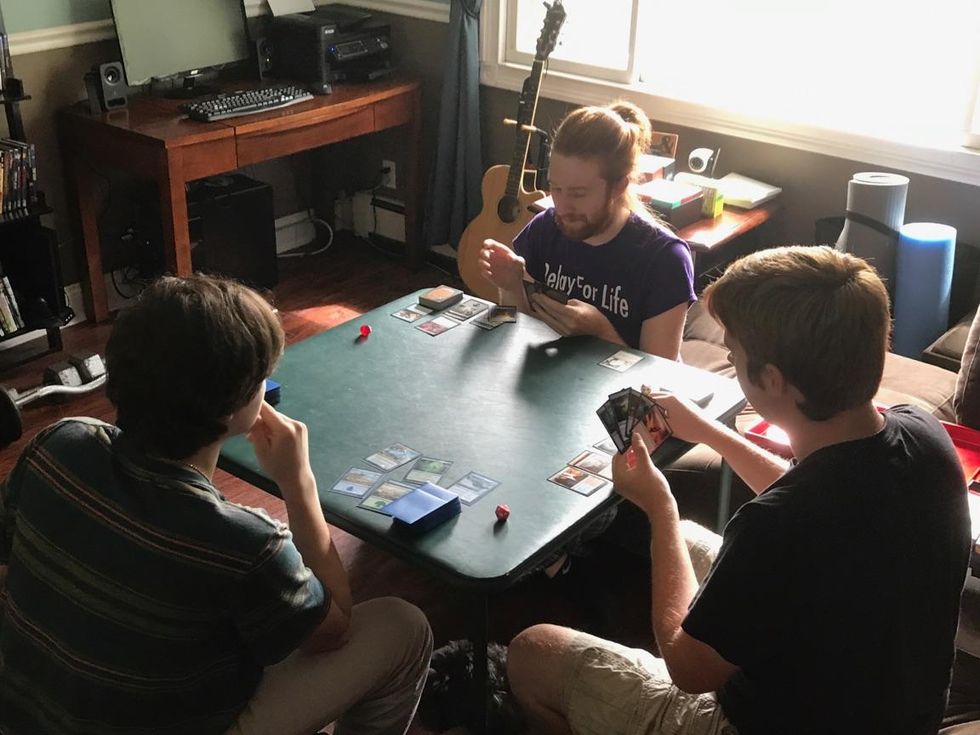I've played Magic The Gathering for a few years now, and from the beginning it was the tactical mindset and competitive play style that drew me deeper. I still have such a love for the game, and have convinced many others to start playing. It's now a big deal between myself and several of my siblings to sit down for a four way battle royale, and very soon, we'll all begin playing EDH together too. "Whoa, slow down, Wyatt! I don't know what any of this means, much less know what EDH is," you may be saying. Well that's great, because I'm about to explain it all in the simplest terms I can!
To start, I'll give some background to the game itself, and the world it takes place in. Welcome, friends, to the Multiverse, a collection of "planes," or different worlds, all just kind of existing. There are many different planes, all with their own unique cultures and populace. People cannot travel between these planes unless they are a planeswalker. It is seemingly random and very rare to be born a planeswalker, but it means that the Multiverse is your playground!
So, the concept of the game is that you, the player, are a planeswalker capable of using magic and pulling creatures from their planes of origin to do battle with other planeswalkers. You do this with your deck of cards. There are several different formats of Magic, but we'll focus on the 60 card formats, the most numerous. These include Standard (consisting of the most recent card expansions), Modern (reaching back quite a few years to 2003), and Legacy (where any Magic card ever printed is legal, with a small ban-list). Once you find your format, with most people playing either Legacy or Modern in a casual home environment, you have to construct your deck.
Decks consist of two parts: lands and spells. Lands are necessary because when you use, or "tap", a land, it gives you one mana of its corresponding color. There are five colors of mana in Magic: red, blue, black, green, and white. You can use these to cast different colors of spells. Each color specializes in different types of magic, and has different mechanics that assist in game play. Most experts suggest building a deck out of two colors, as you will have a greater likelihood of getting the specific color of lands that you need to cast your spells. Spells are the magic that you have available, and the creatures you can summon to protect you. Each one of your spells will have a mana cost, which tells you exactly how much mana, and of what color, you will need to use it. When constructing your deck from these cards, you must have more than sixty cards. There is no limit to how many cards you may have in your deck, so long as you can shuffle it with your own two hands and no assistance.
This all gets a lot more fun when you actually begin to play with another person. Each player begins with twenty life points, and one way to win is to make your opponent lose all their life points. There are a few other ways to win, and a few spells that when certain conditions are met, you can win, but for the most part, games are concerned with life totals. The actual game play is easy to learn once you play a few games. Eventually, you will learn how different cards interact with each other, and create your own ideas for decks. There are so many possibilities with all the cards that have been printed, twenty-five years worth to be precise.
In all honesty, there is so much more to tell, and the game can become needlessly complicated at times, but this is my best shot at explaining it without getting too deep or complex. If you do find yourself interested, stop by your LGS (Local Game Store) and ask for a free starter deck. All certified LGS should have them in stock, as they are a promotional item from the manufacturer. Thanks for letting me rant about something I love, and I hope at least one person finds this interesting and gives it a try.


















